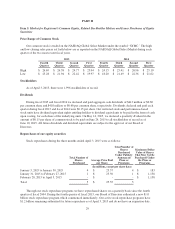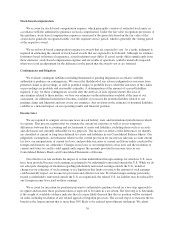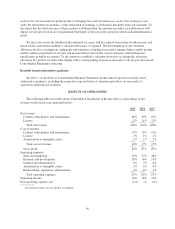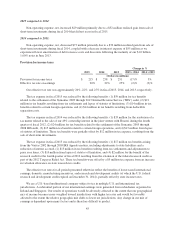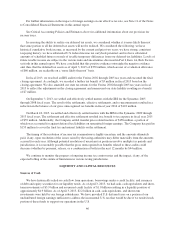Symantec 2015 Annual Report Download - page 117
Download and view the complete annual report
Please find page 117 of the 2015 Symantec annual report below. You can navigate through the pages in the report by either clicking on the pages listed below, or by using the keyword search tool below to find specific information within the annual report.Stock-based compensation
We account for stock-based compensation expense, which principally consists of restricted stock units, in
accordance with the authoritative guidance on stock compensation. Under the fair value recognition provisions of
this guidance, stock-based compensation expense is measured at the grant date based on the fair value of the
award and is generally recognized ratably over the requisite service period, which is generally the vesting period
of the respective award.
We record stock-based compensation expense for awards that are expected to vest. As a result, judgment is
required in estimating the amount of stock-based awards that are expected to be forfeited. Although we estimate
forfeitures based on historical experience, actual forfeitures may differ. If actual results differ significantly from
these estimates, stock-based compensation expense and our results of operations could be materially impacted
when we record an adjustment for the difference in the period that the awards vest or are forfeited.
Contingencies and litigation
We evaluate contingent liabilities including threatened or pending litigation in accordance with the
authoritative guidance on contingencies. We assess the likelihood of any adverse judgments or outcomes from
potential claims or proceedings, as well as potential ranges of probable losses, when the outcomes of the claims
or proceedings are probable and reasonably estimable. A determination of the amount of accrued liabilities
required, if any, for these contingencies is made after the analysis of each separate matter. Because of
uncertainties related to these matters, we base our estimates on the information available at the time of our
assessment. As additional information becomes available, we reassess the potential liability related to our
pending claims and litigation and may revise our estimates. Any revisions in the estimates of potential liabilities
could have a material impact on our operating results and financial position.
Income taxes
We are required to compute our income taxes in each federal, state, and international jurisdiction in which
we operate. This process requires that we estimate the current tax exposure as well as assess temporary
differences between the accounting and tax treatment of assets and liabilities, including items such as accruals
and allowances not currently deductible for tax purposes. The income tax effects of the differences we identify
are classified as current or long-term deferred tax assets and liabilities in our Consolidated Balance Sheets. Our
judgments, assumptions, and estimates relative to the current provision for income tax take into account current
tax laws, our interpretation of current tax laws, and possible outcomes of current and future audits conducted by
foreign and domestic tax authorities. Changes in tax laws or our interpretation of tax laws and the resolution of
current and future tax audits could significantly impact the amounts provided for income taxes in our
Consolidated Balance Sheets and Consolidated Statements of Income.
Our effective tax rate includes the impact of certain undistributed foreign earnings for which no U.S. taxes
have been provided because such earnings are planned to be indefinitely reinvested outside the U.S. While we do
not anticipate changing our intention regarding indefinitely reinvested earnings outside the U.S., material
changes in our estimates of such earnings or tax legislation that limits or restricts the amount of such earnings
could materially impact our income tax provision and effective tax rate. If certain foreign earnings previously
treated as indefinitely reinvested outside the U.S. are repatriated, the related U.S. tax liability may be reduced by
any foreign income taxes paid on these earnings.
We account for uncertain tax positions pursuant to authoritative guidance based on a two-step approach to
recognize and measure those positions taken or expected to be taken in a tax return. The first step is to determine
if the weight of available evidence indicates that it is more likely than not that the tax position will be sustained
on audit, including resolution of any related appeals or litigation processes. The second step is to measure the tax
benefit as the largest amount that is more than 50% likely to be realized upon ultimate settlement. We adjust
39


